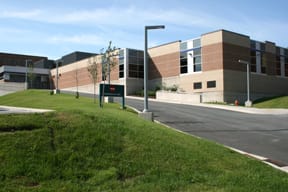No one wants to end up in an emergency department, but if you do happen to be one of the approximately 60,000 patients who will be seen at the Charles V. Keating Emergency and Trauma Centre at the QEII's Halifax Infirmary this year, you'll find yourself in a brand new, $20.4 million, state-of-the-art facility.
The largest centre of its kind in Atlantic Canada, the department serves as a combination of academic referral centre and community hospital. It's also a trauma centre, stroke centre, a burn unit, and provides many specialist and sub-specialized services, like transplant surgery, to patients aged 16 and up from all four of the Atlantic Provinces.

Dr. Sam Campbell, clinical chief of the emergency department, says, "There's a worldwide phenomenon of overcrowding and bed closures in emergency departments and the design of this department follows new paradigms in emergency care by using space maximally."
When patients enter the department, the triage station is directly in front and a large waiting room with comfortable chairs is just to the right. Behind the triage station, the new addition stretches out like a long torso with the nurses' station running through the heart of it. Thirty-five examination rooms branch out from the sides with doorways that go through to what's called the "racetrack" surrounding the unit.
"Traditionally what happens in emergency departments when your family brings you to the hospital is that they usher your family out," says Dr. Campbell. "The new system allows the staff and the family to approach from different sides so that the family aren't getting in the way of the staff." There are comfortable waiting areas for family members as well as internal waiting rooms for patients who don't require beds as they wait for tests to be done and results to come back.
There is brand new equipment in all the rooms; an ultra-fast X-ray and new diagnostic imaging equipment; trauma rooms that can be joined with video monitoring; a new psychiatry unit for emergency psychiatry (including its own independent series of examination and individual waiting rooms); a large and more efficient drive-through ambulance bay; and chemical decontamination areas.
At the very end of the unit are five rooms called the Pod Five-managed by an advanced care paramedic to care for minor injuries. Paramedics are responsible for transporting critically ill or unstable patients, assisting in resuscitations and airway management, casting and splinting, and administering painkillers and sedatives.
"In the new department, we didn't have significant funding to (staff) all the beds with nurses so a lot of the walking wounded are seen by a paramedic," says Dr. Campbell. "Certain things don't need a nurse's care…"
The new emergency department does not include an expanded number of beds, but its redesign allows the beds to be used in a very different way.
Patients will benefit from the new system in many ways. "In the previous department, the beds were only separated by curtains," says Dr. Campbell. And from an infection control perspective it was like one big room with microbes floating around everywhere."
Although this is a state-of-the-art department, it doesn't take away systemic problems. "There's still a shortage of in-patient beds, which tends to cripple the department at times because you can't bring patients in when there's no where to put them," he says.
The emergency department can see 150 patients a day quite comfortably, but when numbers rise to 170 or more, things become much more difficult. "In the last month," says Dr. Campbell, "we've regularly seen 195 to 200 patients a day. When you get a certain amount of people, it becomes very difficult to process that number of patients. Our biggest challenge is still overcrowding and moving people out. There's no where to put them a lot of the time."
In spite of these increased numbers, wait times are slightly better, but not as good as Dr. Campbell would like them. "We are seeing about 200 more patients in a month…" he says. "We're learning to use this system and move patients through far more efficiently. And it's 'way better for the patients. It's quieter, calmer, and more dignified. You can't compare the two departments.
